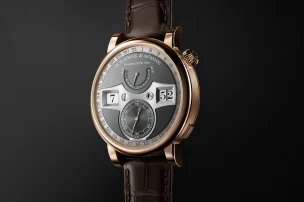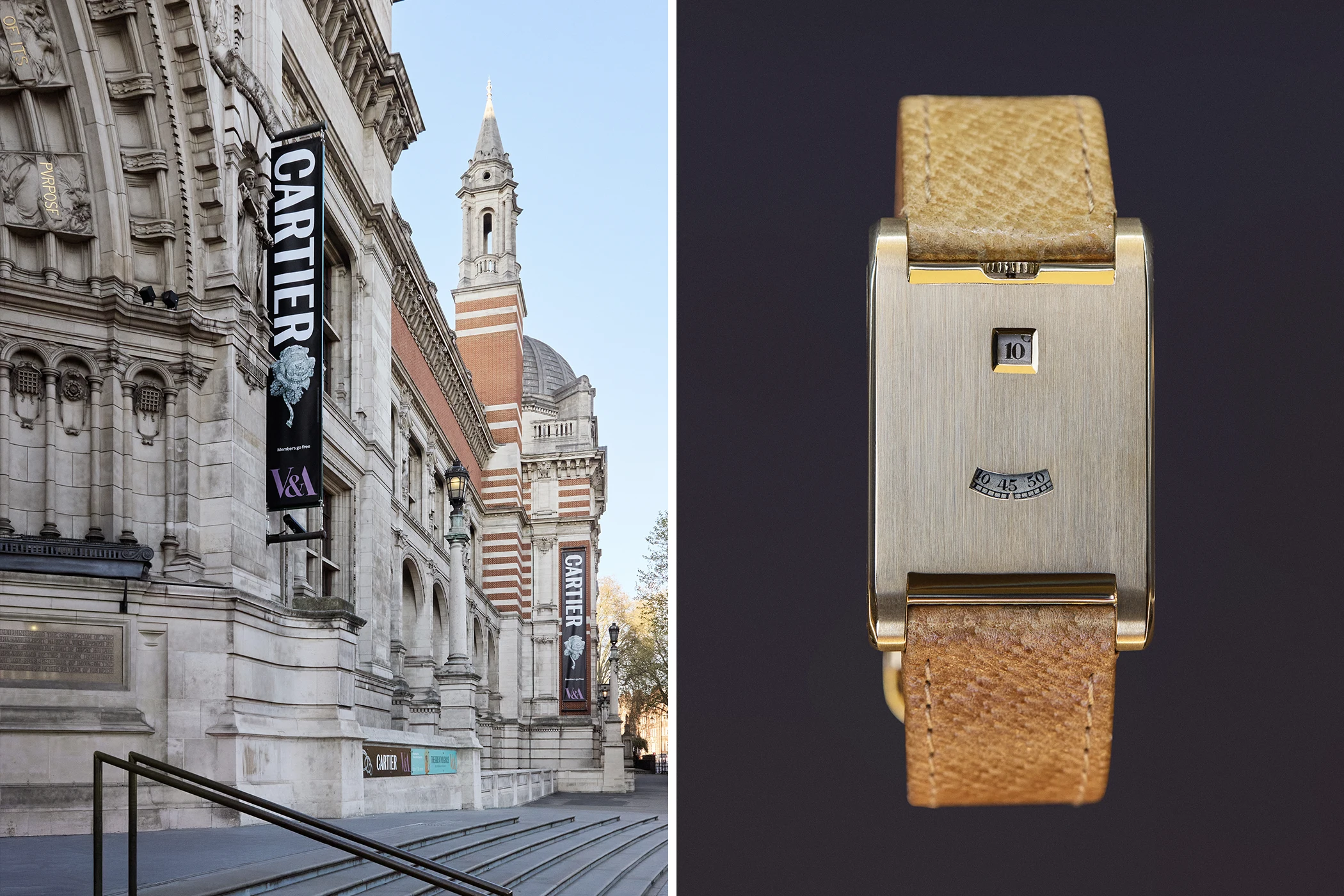The Lange Zeitwerk Date was only available in a white-gold version. Now a new iteration in pink gold with a dark grey dial was released.


Cartier is showcasing the most important watches in the history of the Maison – and much, much more – in an exhibition at the Victoria & Albert Museum in London until 16 November.
The significance of a ‘Royal Warrant’ – the distinction of being a royal purveyor – can be felt not only in museums. When King Charles III recently withdrew this status from the chocolate company Cadbury after 170 years, it caused quite a stir. After all, Cadbury is considered one of Britain’s strongest brands. However, according to reports, the new monarch’s preference for a balanced diet stood in the way of an extension. Cartier, however, is a different case: the Maison still has a letter and seal confirming its particularly close relationship with the royal family. Charles’ appreciation of the fine arts is well known, and Duchess Catherine is not only the owner of a Ballon Bleu, but the Halo Tiara she wore at her wedding is also a historic piece by Cartier from 1936.
But this is only a glimpse of the current line of succession – the depth and breadth of the relationship between the royals, their kingdom, and the Parisian brand can currently be explored by paying a visit to the (regularly sold-out) Cartier exhibition at London’s Victoria & Albert Museum. A stroll through the historic halls in South Kensington quickly turns into a journey back in time to another world: In this cosmos, the creation of unique pieces seems almost self-evident. The only creative limits here are set by the carat budget. And yes, in a rather unique setting, you can admire original models of the first Tank, as well as the Pebble and the Baignoire Allongée, right through to the Crash, but even these are ultimately just one tile in the grand mosaic that this exhibition presents as a work of art.
Until 16 November, the most important watches in the history of the Maison – and many other remarkable pieces – are on display in the exhibition at the Victoria & Albert Museum. After all, London is a very important place in the success story that Cartier can now tell as a matter of course. At the beginning of the 20th century, however, the world of luxury was still a very different one, and although the name Cartier was already well known among the upper class, the Maison, founded in 1847, was still a much smaller business. At that time, Louis, Pierre, and Jacques Cartier – the three grandsons of company founder Louis-François Cartier – set out to expand worldwide. Louis took care of the business at home, while Pierre focused on the US market and moved to New York, and Jacques established the jeweller in London.
There, the first British branch opened on New Burlington Street in 1902. Describing Jacques as an outstanding networker or marketing expert would certainly be too modern a concept in this context. The fact is that in early 20th-century London, he not only quickly gained access to the most exclusive circles, but also found his most important supporter in King Edward VII. The king ordered 27 tiaras for his own coronation in 1902 and, shortly afterwards, awarded the French jeweller the coveted ‘Royal Warrant’ for the first time.
It was the beginning of a sparkling relationship, and apart from countless custom-made pieces for the Royal Family, what strikes you most when walking through the exhibition is the creative range of the ‘jeweller to kings and king of jewellers’. The Cartier aesthetic has always been unmistakable, whether its clients were British aristocrats, Indian maharajas, a Monegasque prince looking for a fitting engagement ring for his bride Grace Kelly, or even Mexican film star Maria Félix.
Anyone who steps into the Tiara Room or lays eyes on treasures like the Patiala Necklace — made of 2,930 diamonds and featuring a 234.65-carat yellow diamond sparkling at its centre — and still wants more can surely be considered insatiable. The necklaces, rings, chains, and brooches are undoubtedly the stars of this exhibition. And yet one must ask: what about the watches? After all, this is a magazine dedicated to mechanical timepieces. But even if that were not the case, it is worth emphasising what extraordinary watches can be found throughout the exhibition.
It is probably both a blessing and a curse for the Maison: as a jeweller, Cartier must constantly explain its watches anew in order to convey that watchmaking is perhaps conceived differently in-house than at other manufacturers, but that this does not make the timepieces any less serious or refined. Quite the opposite actually: by approaching the subject from a design perspective, Cartier has created a unique selling point. In this respect, the success of the new launches in recent years is hardly surprising. The Tank à Guichet presented at Watches & Wonders is also considered a great success, and unlike in previous years, no limited edition is being announced for these models in the Privée collection – probably because demand has always been much greater than the self-imposed limit.
The exhibition features some of the most famous Armand watch designs lined up side by side, including an original Tank à Guichet, the Tank Double Strap, Santos and a Pebble. They impressively demonstrate how the Maison’s designers have always respected the company’s identity, interpreting it in original and contemporary ways time and again. Take the Crash, for example, which is highly sought-after today: it represents the non-conformist spirit of the 1960s in the most sophisticated way possible, while remaining quintessentially Cartier. However, the most exciting provenance of the watches belongs to a Tank from 1962, which, from a purely visual point of view, does not particularly stand out among the exhibits, but nevertheless deserves a third and fourth look. This watch once belonged to Jackie Kennedy, a gift from her brother-in-law Prince Stanislaw Radziwill, who purchased it at Cartier New York. From then on, a woman of class wore a watch with class. Decades later, this very model was auctioned off to Kim Kardashian for around 380,000 euros. At this point, everyone can embark on their own personal journey of reflection and ponder how our understanding of style, female self-awareness, and celebrity may have changed over the decades, while classics such as the Tank have clearly stood the test of time in every decade. Incidentally, according to the catalogue, the watch is now owned by the Cartier Collection.
In addition to familiar wristwatches, collectors in London will be particularly impressed by the diversity of Cartier’s watchmaking expertise. Among the items on display are horological accessories such as a letter opener from 1930 decorated with agate and lapis lazuli and a clock in the handle. There is also a wide variety of table clocks that could not be more different.
There is, for example, a model from 1927 whose striking mechanism audibly signals the hours and quarter hours and is visually inspired by ancient Egypt. Hieroglyphs were carved into mother-of-pearl plates, and the whole piece is designed in the style of the entrance to the Temple of Khonsu in Karnak. A table clock with an inkwell from 1908 has a completely different look. It features guilloché and enamel techniques, resulting in a shimmering purple-grey work of art in the style of Louis XVI.
The history of mystery clocks is beautifully showcased through several examples, including the famous ‘Portal’ version from 1923. The design is inspired by the entrance to a Shinto shrine, on which a pot-bellied ‘Billiken’, a crystal glass lucky charm, is enthroned. The clockwork is hidden directly underneath it, while the hands appear to float on the glass dial. Another ‘Mystery Clock’, whose hands and dial rim are set with diamonds, dates back to 1914. The watch is one of the first of its kind, conceived by watchmaker Maurice Coüet, whom Louis Cartier hired exclusively for the Maison in 1911.
One of the special features of Cartier’s success in the United Kingdom is that the French brand presents itself as British as possible. This is not so much because of Cartier representative Laurent Feniou’s annual appearance alongside the Queen at the Queen’s Cup polo tournament — an event long embedded in the capital’s social scene — but rather the fact that the company opened its own workshops in London in 1921, called ‘English Artworks’, so that French designs could be produced by British craftsmen. With this ‘Made in England’ approach, the company followed a markedly different strategy in the United Kingdom than in the United States, where customers viewed the French origin of jewellery and watches as a hallmark of quality and style.
Aside from Cartier’s New York flagship on 5th Avenue, the New Bond Street boutique is perhaps the best place to experience the brand’s soul outside Paris today. While other boutiques on this street may come and go, this location has been home to Cartier for ages, and anyone walking through the first room of the boutique will inevitably pass by Jacques Cartier’s former office. So even after the exhibition at the Victoria & Albert Museum comes to a close, London will still offer another truly authentic place to experience Cartier. Notably, a rare and coveted skeletonised Asymétrique was on display in a showcase during our visit. Although this may not be a permanent fixture, the sheer number of extraordinary pieces from the current collection is impressive – making the boutique a museum-like pilgrimage site for Cartier collectors anyway.